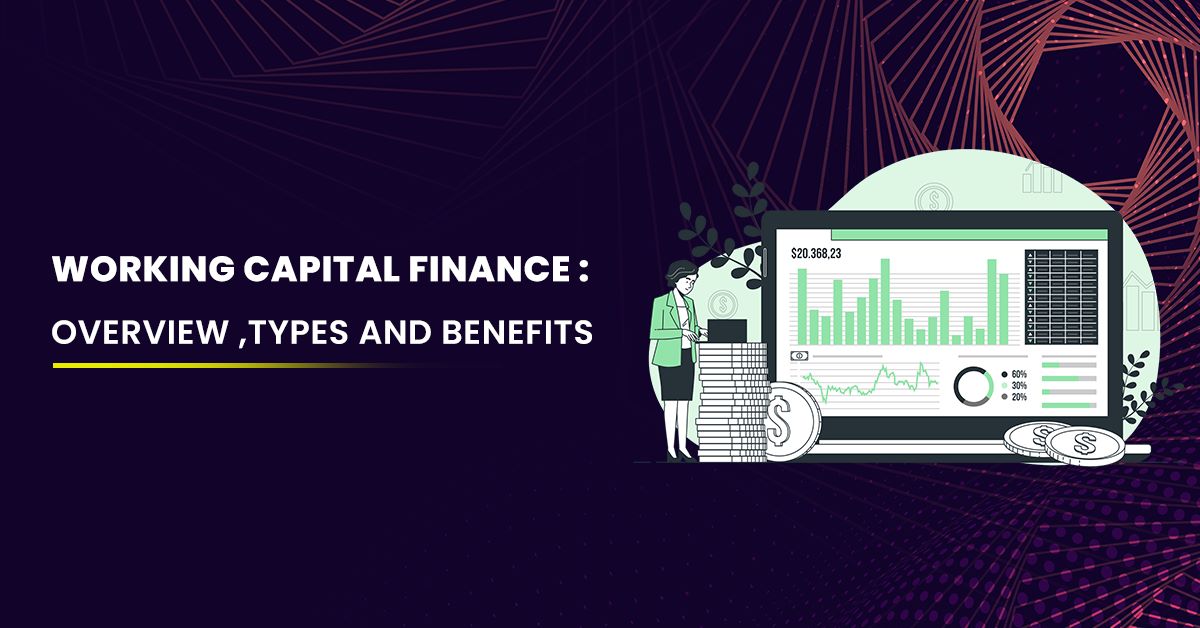Working Capital Finance: Overview, Types and Benefits
March 16, 2023
Admin
Working Capital Finance Capital Finance Working Capital Finance in IndiaWorking capital financing
What is Working Capital Financing?
Working capital financing is used to finance your business's investment in short-term assets like inventory and accounts receivable as well as to offer liquidity so your business can fund its daily operations, such as paying employees, covering overhead, and paying other costs. Working capital finance is relevant to businesses where the company’s current liabilities exceed its current assets. Small and medium-sized businesses frequently use this sort of financing as their present assets don't cover their current liabilities. Loans, sales, assignments, guarantees, and preferential conditions from clients and suppliers are all sources of working capital financing.

Types of Working Capital Finance
- Working Capital Revolver - A working capital revolver is a line of credit where the maximum borrowing limit is determined by the quantity of inventory and accounts receivable on the company's balance sheet. This secured credit line is referred to as a revolver since money may be borrowed, paid back, and then reborrowed repeatedly.
- Accounts Receivable Factoring - By exchanging outstanding invoices for cash advances, one may finance the firm through accounts receivable factoring. A factoring business pays a sizeable portion of the unpaid invoice amount, pursues payment from clients, and then pays the balance of debt, minus fees. Only businesses that sell on credit terms, in which the borrower (the vendor) sells an item (or service) and issues an invoice to the customer for payment at a later time, are eligible for factoring as a funding source. This expected future payment is shown as an account receivable on the vendor's balance sheet (a current asset).
- Purchase Order Financing - Purchase order financing is a short-term commercial finance option that provides capital to pay suppliers upfront for verified purchase orders. In such an arrangement, a third party agrees to provide a supplier with enough money to cover a customer's purchase order. Purchase order loans can finance an order in its entirety in some circumstances or just a portion of it in others.
- Trade Finance - Trade finance refers to the financial tools and products that businesses employ to facilitate global trade and commerce. In order to eliminate the supply and payment risks from transactions, trade finance introduces a third party to the transactions. In trade finance, the exporter receives receivables or payment in accordance with the contract, and the importer may be given credit to complete the trade order.
- Customer Advances - Customer advances are monetary payments made to a business before it provides its customers with products or services. A significant source of "no-cost" working capital finance is offered by these advances. Of course, the business becomes obligated to deliver the products or services to the client in the future; this obligation is often recorded as a deferred revenue liability on the balance sheet of the business.
- Vendor Credit - Vendor financing is a sort of credit where a supplier lends money to a buyer who then uses it to pay for the supplier's goods and services. Vendor credit gives the option to postpone paying for products or services received from a supplier or vendor for a certain length of time. Payment terms could include an early payment discount or a late payment charge.
- MRR Line of Credit - An MRR line of credit is a type of loan product where the amount that may be borrowed is directly correlated with the borrower's monthly recurring revenue. Lines of credit are typically offered to businesses that have inventory and/or accounts receivable to serve as a basis of collateral for the loan.
- Merchant Cash Advances - In return for a portion of daily credit/debit card revenues in the future, one can obtain merchant cash advances (MCAs), which are up-front payments. An MCA is a sale of future income rather than a loan. Although this type of financing is pricey, it can be the best option for a company that performs a lot of credit card transactions but has little or no credit history.
Some potential benefits of working capital finance include the following:
- Improved cash flow: Working capital finance can provide a company with the necessary cash to meet its short-term obligations, helping to ensure that it has the liquidity it needs to operate effectively.
- Greater flexibility: Working capital financing can be used to fund a wide range of short-term needs, giving a company the flexibility to adapt to changing market conditions or pursue new opportunities.
- Enhanced competitiveness: By having access to the funds, it needs to cover its short-term expenses, a company can maintain a strong financial position and remain competitive in its market.
- Ability to take advantage of discounts: Working capital finance can allow a company to take advantage of discounts for bulk purchases or early payment, which can help to reduce costs and improve profitability.
Conclusion:
Working capital loans are not intended for the purchase of any assets or long-term investments. These loans might be either secured or unsecured. Assuring that the company has enough cash flow to cover its operating costs is the main reason for using working capital financing. Working capital finance, to put it simply, is a method of generating cash flow that enables a company to continue operations by receiving payment for ongoing projects or restocking items that were sold on credit.